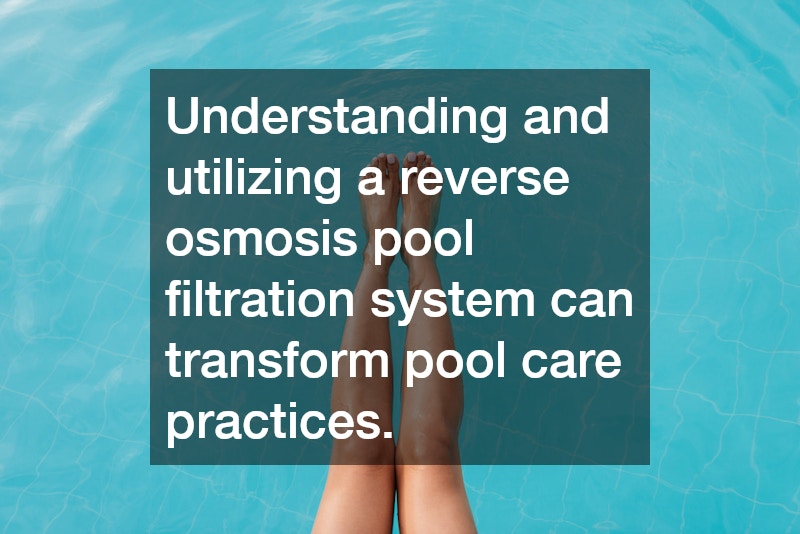In the world of swimming pool maintenance, reverse osmosis pool filtration systems are gaining popularity as a highly effective solution for water purification. These systems offer superior filtration capability compared to traditional methods, providing clear and clean water without the need for excessive chemical treatments.
As pool owners increasingly prioritize both the quality of their pool water and environmental considerations, reverse osmosis has emerged as a viable and attractive option.
Reverse osmosis (RO) is a water purification process that uses a semi-permeable membrane to remove ions, unwanted molecules, and larger particles from water. The technology is extensively used in various industries and applications, from drinking water purification to wastewater treatment, and now increasingly in swimming pool maintenance. By understanding how reverse osmosis pool filtration systems function, pool owners can make informed decisions on maintaining the health and safety of their pools.
This system is particularly beneficial for pools in regions with high mineral content in their water supply. In such areas, the build-up of hard minerals and other impurities can lead to scale formation and cloudy water if not properly managed. By investing in a reverse osmosis pool filtration system, owners can ensure crystal-clear water that promotes a healthier swimming environment while reducing dependency on traditional chemical treatments.
How Does a Reverse Osmosis Pool Filtration System Work?
A reverse osmosis pool filtration system operates by pushing pool water through a fine membrane under high pressure. This membrane is specially designed to trap impurities, allowing only pure water molecules to pass through while leaving contaminants behind. Captured impurities are then flushed out of the system, preventing the build-up of scale and organic material in the pool.
The effectiveness of an RO system lies in its multi-stage filtration process. Initially, a pre-filter removes larger debris and sediments, extending the lifespan of the RO membrane. The reverse osmosis stage follows, effectively targeting smaller particles, including dissolved salts, bacteria, and viruses, resulting in significantly improved water quality.
Importantly, reverse osmosis systems are designed to be energy efficient. Unlike other water treatment methods that require extensive chemical usage or heating, RO systems rely primarily on water pressure and the natural separation process, making them both economical and environmentally friendly. This adaptability makes them an ideal choice for a variety of pool sizes and environmental conditions.
Benefits of Using a Reverse Osmosis Pool Filtration System
One of the primary benefits of a reverse osmosis pool filtration system is its ability to produce high-quality water. By effectively removing dissolved solids and contaminants, these systems enhance water clarity and safety, creating an optimal swimming experience. Additionally, the reduction in chemical usage not only safeguards the health of swimmers but also helps protect surrounding ecosystems.
Another significant advantage is the system’s contribution to the longevity of pool equipment. By minimizing scale build-up and corrosion, reverse osmosis preserves the integrity of pumps, heaters, and plumbing systems. This reduction in equipment wear and tear translates to lower maintenance costs and less frequent replacements, saving pool owners money in the long run.
Moreover, utilizing reverse osmosis technology in pool water treatment can be a sustainable choice. By reducing the need to frequently replace pool water due to high impurity levels, owners can conserve water—a precious resource, especially in drought-prone areas. This environmental benefit, coupled with improved water quality, makes reverse osmosis systems an attractive investment for conscientious pool owners.
Considerations When Choosing a Reverse Osmosis Pool Filtration System
When selecting a reverse osmosis pool filtration system, several factors need to be taken into account. First, the specific water quality issues that need addressing, such as mineral content and pathogen presence, will influence the choice of system. Consulting with a water treatment specialist can help identify these requirements and the ideal system capacity and configuration for your pool.
Cost is another critical consideration; while reverse osmosis systems offer long-term savings, the upfront investment can be significant. Carefully evaluate budget constraints, potential energy costs, and maintenance needs against the benefits of improved water quality and equipment protection. Pool owners should also consider the local environmental conditions, as these can impact both system performance and maintenance frequency.
Finally, it’s important to ensure compatibility with existing pool equipment and the ease of integration into your current setup. Some systems may require additional space or modifications, so planning for any necessary adjustments can prevent operational interruptions. In some cases, hiring professional installers can provide peace of mind and ensure optimal performance of the new system.
Understanding and utilizing a reverse osmosis pool filtration system can transform pool care practices. As environmental awareness and technological advancements continue to shape industry standards, pool owners have the opportunity to lead by example. By making informed decisions today, they can ensure that their pools provide clean, safe, and enjoyable experiences for years to come.




